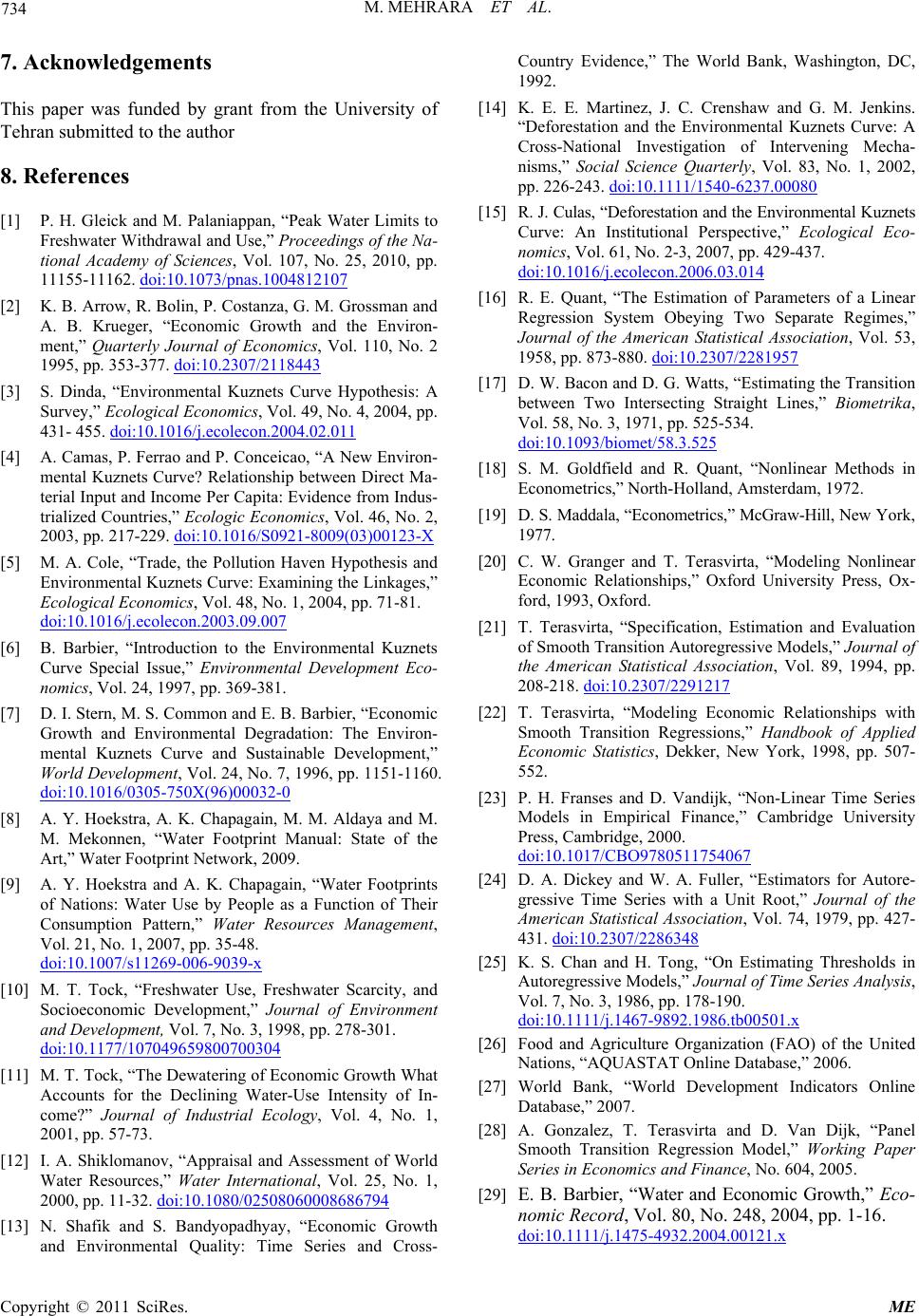
M. MEHRARA ET AL.
734
7. Acknowledgements
This paper was funded by grant from the University of
Tehran submitted to the author
8. References
[1] P. H. Gleick and M. Palaniappan, “Peak Water Limits to
Freshwater Withdrawal and Use,” Proceedings of the Na-
tional Academy of Sciences, Vol. 107, No. 25, 2010, pp.
11155-11162. doi:10.1073/pnas.1004812107
[2] K. B. Arrow, R. Bolin, P. Costanza, G. M. Grossman and
A. B. Krueger, “Economic Growth and the Environ-
ment,” Quarterly Journal of Economics, Vol. 110, No. 2
1995, pp. 353-377. doi:10.2307/2118443
[3] S. Dinda, “Environmental Kuznets Curve Hypothesis: A
Survey,” Ecological Economics, Vol. 49, No. 4, 2004, pp.
431- 455. doi:10.1016/j.ecolecon.2004.02.011
[4] A. Camas, P. Ferrao and P. Conceicao, “A New Environ-
mental Kuznets Curve? Relationship between Direct Ma-
terial Input and Income Per Capita: Evidence from Indus-
trialized Countries,” Ecologic Economics, Vol. 46, No. 2,
2003, pp. 217-229. doi:10.1016/S0921-8009(03)00123-X
[5] M. A. Cole, “Trade, the Pollution Haven Hypothesis and
Environmental Kuznets Curve: Examining the Linkages,”
Ecological Economics, Vol. 48, No. 1, 2004, pp. 71-81.
doi:10.1016/j.ecolecon.2003.09.007
[6] B. Barbier, “Introduction to the Environmental Kuznets
Curve Special Issue,” Environmental Development Eco-
nomics, Vol. 24, 1997, pp. 369-381.
[7] D. I. Stern, M. S. Common and E. B. Barbier, “Economic
Growth and Environmental Degradation: The Environ-
mental Kuznets Curve and Sustainable Development,”
World Development, Vol. 24, No. 7, 1996, pp. 1151-1160.
doi:10.1016/0305-750X(96)00032-0
[8] A. Y. Hoekstra, A. K. Chapagain, M. M. Aldaya and M.
M. Mekonnen, “Water Footprint Manual: State of the
Art,” Water Footprint Network, 2009.
[9] A. Y. Hoekstra and A. K. Chapagain, “Water Footprints
of Nations: Water Use by People as a Function of Their
Consumption Pattern,” Water Resources Management,
Vol. 21, No. 1, 2007, pp. 35-48.
doi:10.1007/s11269-006-9039-x
[10] M. T. Tock, “Freshwater Use, Freshwater Scarcity, and
Socioeconomic Development,” Journal of Environment
and Development, Vol. 7, No. 3, 1998, pp. 278-301.
doi:10.1177/107049659800700304
[11] M. T. Tock, “The Dewatering of Economic Growth What
Accounts for the Declining Water-Use Intensity of In-
come?” Journal of Industrial Ecology, Vol. 4, No. 1,
2001, pp. 57-73.
[12] I. A. Shiklomanov, “Appraisal and Assessment of World
Water Resources,” Water International, Vol. 25, No. 1,
2000, pp. 11-32. doi:10.1080/02508060008686794
[13] N. Shafik and S. Bandyopadhyay, “Economic Growth
and Environmental Quality: Time Series and Cross-
Country Evidence,” The World Bank, Washington, DC,
1992.
[14] K. E. E. Martinez, J. C. Crenshaw and G. M. Jenkins.
“Deforestation and the Environmental Kuznets Curve: A
Cross-National Investigation of Intervening Mecha-
nisms,” Social Science Quarterly, Vol. 83, No. 1, 2002,
pp. 226-243. doi:10.1111/1540-6237.00080
[15] R. J. Culas, “Deforestation and the Environmental Kuznets
Curve: An Institutional Perspective,” Ecological Eco-
nomics, Vol. 61, No. 2-3, 2007, pp. 429-437.
doi:10.1016/j.ecolecon.2006.03.014
[16] R. E. Quant, “The Estimation of Parameters of a Linear
Regression System Obeying Two Separate Regimes,”
Journal of the American Statistical Association, Vol. 53,
1958, pp. 873-880. doi:10.2307/2281957
[17] D. W. Bacon and D. G. Watts, “Estimating the Transition
between Two Intersecting Straight Lines,” Biometrika,
Vol. 58, No. 3, 1971, pp. 525-534.
doi:10.1093/biomet/58.3.525
[18] S. M. Goldfield and R. Quant, “Nonlinear Methods in
Econometrics,” North-Holland, Amsterdam, 1972.
[19] D. S. Maddala, “Econometrics,” McGraw-Hill, New York,
1977.
[20] C. W. Granger and T. Terasvirta, “Modeling Nonlinear
Economic Relationships,” Oxford University Press, Ox-
ford, 1993, Oxford.
[21] T. Terasvirta, “Specification, Estimation and Evaluation
of Smooth Transition Autoregressive Models,” Journal of
the American Statistical Association, Vol. 89, 1994, pp.
208-218. doi:10.2307/2291217
[22] T. Terasvirta, “Modeling Economic Relationships with
Smooth Transition Regressions,” Handbook of Applied
Economic Statistics, Dekker, New York, 1998, pp. 507-
552.
[23] P. H. Franses and D. Vandijk, “Non-Linear Time Series
Models in Empirical Finance,” Cambridge University
Press, Cambridge, 2000.
doi:10.1017/CBO9780511754067
[24] D. A. Dickey and W. A. Fuller, “Estimators for Autore-
gressive Time Series with a Unit Root,” Journal of the
American Statistical Association, Vol. 74, 1979, pp. 427-
431. doi:10.2307/2286348
[25] K. S. Chan and H. Tong, “On Estimating Thresholds in
Autoregressive Models,” Journal of Time Series Analysis,
Vol. 7, No. 3, 1986, pp. 178-190.
doi:10.1111/j.1467-9892.1986.tb00501.x
[26] Food and Agriculture Organization (FAO) of the United
Nations, “AQUASTAT Online Database,” 2006.
[27] World Bank, “World Development Indicators Online
Database,” 2007.
[28] A. Gonzalez, T. Terasvirta and D. Van Dijk, “Panel
Smooth Transition Regression Model,” Working Paper
Series in Economics and Finance, No. 604, 2005.
[29] E. B. Barbier, “Water and Economic Growth,” Eco-
nomic Record, Vol. 80, No. 248, 2004, pp. 1-16.
doi:10.1111/j.1475-4932.2004.00121.x
Copyright © 2011 SciRes. ME